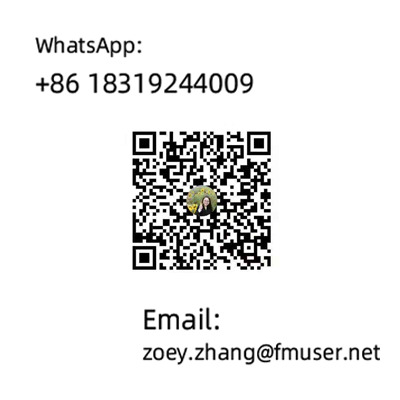Products Category
- FM Transmitter
- 0-50w 50w-1000w 2kw-10kw 10kw+
- TV Transmitter
- 0-50w 50-1kw 2kw-10kw
- FM Antenna
- TV Antenna
- Antenna Accessory
- Cable Connector Power Splitter Dummy Load
- RF Transistor
- Power Supply
- Audio Equipments
- DTV Front End Equipment
- Link System
- STL system Microwave Link system
- FM Radio
- Power Meter
- Other Products
- Special for Coronavirus
Products Tags
Fmuser Sites
- es.fmuser.net
- it.fmuser.net
- fr.fmuser.net
- de.fmuser.net
- af.fmuser.net ->Afrikaans
- sq.fmuser.net ->Albanian
- ar.fmuser.net ->Arabic
- hy.fmuser.net ->Armenian
- az.fmuser.net ->Azerbaijani
- eu.fmuser.net ->Basque
- be.fmuser.net ->Belarusian
- bg.fmuser.net ->Bulgarian
- ca.fmuser.net ->Catalan
- zh-CN.fmuser.net ->Chinese (Simplified)
- zh-TW.fmuser.net ->Chinese (Traditional)
- hr.fmuser.net ->Croatian
- cs.fmuser.net ->Czech
- da.fmuser.net ->Danish
- nl.fmuser.net ->Dutch
- et.fmuser.net ->Estonian
- tl.fmuser.net ->Filipino
- fi.fmuser.net ->Finnish
- fr.fmuser.net ->French
- gl.fmuser.net ->Galician
- ka.fmuser.net ->Georgian
- de.fmuser.net ->German
- el.fmuser.net ->Greek
- ht.fmuser.net ->Haitian Creole
- iw.fmuser.net ->Hebrew
- hi.fmuser.net ->Hindi
- hu.fmuser.net ->Hungarian
- is.fmuser.net ->Icelandic
- id.fmuser.net ->Indonesian
- ga.fmuser.net ->Irish
- it.fmuser.net ->Italian
- ja.fmuser.net ->Japanese
- ko.fmuser.net ->Korean
- lv.fmuser.net ->Latvian
- lt.fmuser.net ->Lithuanian
- mk.fmuser.net ->Macedonian
- ms.fmuser.net ->Malay
- mt.fmuser.net ->Maltese
- no.fmuser.net ->Norwegian
- fa.fmuser.net ->Persian
- pl.fmuser.net ->Polish
- pt.fmuser.net ->Portuguese
- ro.fmuser.net ->Romanian
- ru.fmuser.net ->Russian
- sr.fmuser.net ->Serbian
- sk.fmuser.net ->Slovak
- sl.fmuser.net ->Slovenian
- es.fmuser.net ->Spanish
- sw.fmuser.net ->Swahili
- sv.fmuser.net ->Swedish
- th.fmuser.net ->Thai
- tr.fmuser.net ->Turkish
- uk.fmuser.net ->Ukrainian
- ur.fmuser.net ->Urdu
- vi.fmuser.net ->Vietnamese
- cy.fmuser.net ->Welsh
- yi.fmuser.net ->Yiddish
What is Broadcast relay station and its Types
A broadcast relay station, relay transmitter, broadcast translator (U.S.), rebroadcaster (Canada), or repeater (two-way radio) is a broadcast transmitter which relays or repeats the signal of another radio station or television station, usually to an area not covered by the signal of the originating station. They may serve, for example, to expand the broadcast range of a television or radio station beyond the primary signal's coverage area, or to improve service in a part of the main coverage area which receives a poor signal due to geographic constraints. They may (but are not usually) used to create a single-frequency network.

Some fully-licensed stations simply simulcast another station. These are relay stations only in name, and are generally licensed the same as any other major station. This is not regulated in the U.S., and it is also widely allowed in Canada, which otherwise regulates radio formats to ensure a diverse variety of programming.
Boosters
Relays which broadcast within or very near the parent station's coverage area (a "fill-in") on the same channel or frequency are called booster stations in the U.S. However, this can be tricky because it is possible to have both stations interfering with each other unless they are carefully designed. Radio interference can be avoided by using exact atomic time obtained from GPS satellites to perfectly synchronise co-channel stations, as in a single-frequency network (SFN).
Analog TV stations cannot have same-channel boosters unless opposite (perpendicular) polarisation is used, due to video synchronization issues such as ghosting. In the US, no new on-channel UHF signal boosters have been authorized since July 11, 1975.[1] Digital TV stations are technically capable of sharing a channel, however this is more difficult with the 8VSB modulation and invariable guard interval used in the ATSC standard than with COFDM used in the European and Australian DVB-T standard. US AM broadcasting stations do not have translators or boosters; though an SFN is actually easier to create in their frequency band, it is largely unnecessary as the longer wavelengths of these signals are more able to provide adequate coverage over longer distances despite a lack of line-of-sight transmission conditions.
Distributed transmission
Distributed transmission (DTx) is the use of several medium-power stations (usually digital) to cover a broadcast area, rather than one high-power and several low-power stations. Experiments have shown that this can be done even with ATSC if A-VSB is used. The use of virtual channels is another alternative, though this may cause the same channel to appear multiple times on a receiver (once for each relay station), and requires the user to tune manually to the best one (which changes due to radio propagation conditions like weather). Use of boosters or DTx instead causes all relay stations to ideally appear as a single signal, but requires significant broadcast engineering to work properly and not cause destructive interference to each other's signals.
Semi-satellites
A television rebroadcaster often sells local or regional advertising for broadcast only on the local transmitter, and may also air a very limited amount of distinct programming from their parent station. Some such "semi-satellites" broadcast their own local newscasts, or separate news segments during part of the newscast. For example, CHEX-TV-2 in Oshawa, Ontario airs separate daily late afternoon-early evening news and community broadcasts from its parent station, CHEX-TV in Peterborough, The U.S. FCC prohibits this on FM translator stations, only allowing it on different fully-licensed stations.
National networks
Most broadcasters outside of North America maintain a national network and use several relay transmitters to provide the same service to a region or entire nation. In comparison to the other types of relays explained above, the transmitter network is often created and maintained by an independent authority, often paid for using license fees, and major broadcasters use the same transmitters.
If you would like to build a radio station, boost your FM radio transmitter or need any other FM equipment, please feel free to contact us: [email protected].





